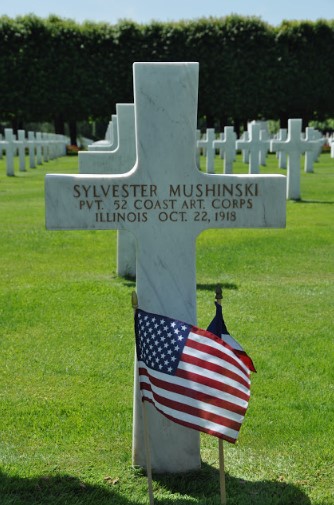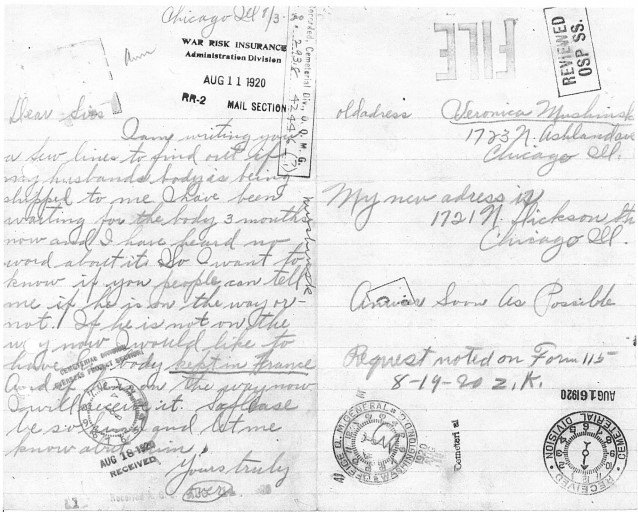Private Sylvester Mushinski

- Unit: 52nd Artillery Regiment, Coastal Artillery Corps, Company F
- Date of Birth: December 4, 1892
- Entered the Military: June 3, 1917
- Date of Death: October 22, 1918
- Hometown: Wild Rose, Wisconsin
- Place of Death: Field Hospital Number 13, Limoges, Haut-Vienne, France
- Cemetery: Plot A, Row 14, Grave 13. St. Mihiel American Cemetery, Thiaucourt, France
Almond-Bancroft School
2018-2019
Early Life
On December 4, 1892, Sylvester Mushinski was born to Anna and Cashmere Mushinski in Wild Rose, Wisconsin. Sylvester’s father and grandfather came to the United States in 1881 from Polish Germany, and were among the first Polish immigrants to the Wild Rose area. Cashmere’s future wife, Anna, immigrated to the United States in 1891; she came alone looking for her aunt and cousin who had moved to Wild Rose a few years previously. In 1892 Cashmere and Anna met.
Mushinski was the first of eight children. The Mushinski family was part of a surge of Polish immigration to central Wisconsin around the time Sylvester was born. Mushinski’s grandfather invested in land around the city of Wild Rose, just southeast of another central Wisconsin Polish community, Stevens Point.
The small Polish community in the area had purchased the land from Welsh settlers, who knew how challenging the area was for agriculture, but failed to fully disclose this to the immigrants. The Mushinskis found the land in this area to be less than ideal for farming. In the first decade of the twentieth century, the Mushinski family experienced hardships, as two of the sons died and the family struggled to cultivate the rocky and marshy soil. Food shortages and sickness pushed Mushinski’s father to consider his past experiences in his future planning. He moved the family to Chicago, Illinois.
By 1910, the Mushinskis lived at 1447 Redfield Street on Goose Island, on the North Fork of the Chicago River. They owned a house in a small residential patch that was surrounded by the Finkl Brothers Steel Company. Sylvester and his father worked in the mill, though Mushinski eventually found different work in furniture making. The Mushinski’s house became a tavern and boarding room for local Polish steel workers. This part of Chicago became known as “Little Polonia.” By 1910, over 200,000 Polish immigrants called Chicago their home.
Sometime after 1910, Cashmere, Anna, and Sylvester’s six siblings left Chicago and moved back to Wild Rose, Wisconsin. Sylvester chose to stay in the city. In 1912, Mushinski married Veronica Sylata, a recent Polish immigrant. In December 1912, Veronica gave birth to their son, Harry. They welcomed twin daughters, Eleanore and Bronislava, in 1914. Their fourth child, Mildred, was born in 1916. Both Bronislava and Mildred died before their third birthday.
Mushinski worked as a press operator for Palmer Equipment, a furniture manufacturer on the south side of Chicago. The family lived at 1501 McHenry Street in Chicago until 1917.
Chicago’s large ethnic Polish population generally supported the Allied war effort even before the United States declared war on April 6, 1917. Many south side Polish migrants faced starvation under German and Austro-Hungarian regimes before immigrating to the United States.
The local draft board of the 16th Ward acted as part of the Selective Service Act of 1917 to tap young men in the community to fight for their country. Many Poles in Little Polonia volunteered to serve. Sylvester, however, marked the need for an exemption for his service. As the sole breadwinner of his family, his absence could cause a serious disturbance in their livelihood. Nevertheless, in July 1917, Mushinski received orders to report for duty.



Military Experience
The U.S. Army initially sent Mushinski to Fort Winfield Scott in the Presidio of San Francisco, California. Private Mushinski’s training included marksmanship practice, physical training, and artillery maneuvers.
In May and June 1918, the German army launched their final military offensive against the Western Front. The number of American troops in France grew to well over a million by May 1918. On June 28, 1918, Mushinski boarded the British ocean liner Saxon in New York City as part of a replacement detachment.
Upon arriving in Europe, he was reassigned to the 52nd Artillery Regiment, Coastal Artillery Corps, Company F, stationed in Dommartin-la-Planchette, France. Mushinski worked specifically on railway guns, 105mm and 130mm guns mounted on a rail car. Railroad artillery units were common on the French front.
In July and August the 52nd Artillery Regiment, drilled and practiced operating the new railway guns. Heavy shelling from German guns from July 15 to 18 shook the company, though few American casualties were reported during the German attack. Mushinski’s regiment continued to fire shells back toward German targets during the bombardment.
In the fall of 1918, the Allied forces repelled the German summer offensive and began the last major offensive of the war. During September and October, artillery barrages helped provide the Meuse-Argonne offensive with support. Company F was active in the offensive and destroyed a German observation post during shelling.
By September 1918, influenza swept through the Western Front. Mushinski fell ill on October 14. He was transported to Field Hospital Number 13 in Limoges, France. The hospital was set up in abandoned buildings about 600 kilometers by train from Dommartin-la-Planchette. The hospital saw its fair share of wounded, but remarked that in September and October of 1918 they saw a jump of influenza patients. In Mushinski’s company there were three who died of pneumonia as a resulting complication of influenza from October 18 to 24.
Mushinski was pronounced dead on October 22, 1918, just three weeks before the signing of the armistice on November 11.
.jpg)
.jpg)
.jpg)
Eulogy
When informed by the U.S. Army that Private Mushinski’s remains could be returned home, his wife Veronica stated that she wanted him returned to Chicago. She hoped to say her final goodbyes to her husband in person.
In April 1919, the War Department informed her that this was not possible. Upon receiving this correspondence, Veronica chose to allow her husband’s body stay in France. His body, originally buried at the hospital graveyard, was moved to St. Mihiel American Cemetery in Thiaucourt, France.
In 1929 and 1931, Mushinski’s mother, Anna, declined the opportunity to participate in a Gold Star Mothers Pilgrimage, citing failing health.



Reflection
Bibliography
47th – 52nd Regiments, Coastal Artillery Corps; Records of the Adjutant General’s Office, Record Group 407 (Box 1016); National Archives at College Park, College Park, MD.
52nd Coastal Artillery Regiments; Records of the Historical Section Relating to the History of the War Department, 1900-1941, Records of the War Department General and Special Staffs, Record Group 165 (Boxes 326-327); National Archives at College Park, College Park, MD.
“Anna Mushinski.” U.S. World War I Mothers’ Pilgrimage, 1929. Digital Images. ancestry.com.
Bruso, David. “Poland to America: Polish Immigrants in Chicago and Their Reactions to the Start of World War I.” Minds of Wisconsin. May/June 2017. Accessed May 2019. minds.wisconsin.edu/bitstream/handle/1793/76843/Bruso_David_2017Spring_Hist489.pdf?sequence=2 .
Camp Hospital #12 and Camp Hospital #13; World War I Organization Records, Medical Department, Records of the American Expeditionary Forces – World War I, Record Group 120 (Boxes 571-572); National Archives at College Park, College Park, MD.
Duff, Sergeant A. C. 320-mm gun in action…north of Mailly, France. Photograph. May 15, 1918. National Archives and Records Administration (111-SC-12441-ac). Image.
Ibid. It takes four husky artillerymen to carry…north of Mailly, France. Photograph. May 15, 1918. National Archives and Records Administration (111-SC-12439-ac). Image.
Ibid. Loading a 24-G gun, 52nd Coast Artillery Corps…north of Mailly, France. Photograph. May 15, 1918. National Archives and Records Administration (111-SC-12500-ac). Image.
Grossman, Ron. “How WWI Was Fought in Chicago’s Ethnic Neighborhoods.” Chicago Tribune, May 31, 2019. www.chicagotribune.com/opinion/commentary/ct-perspec-flash-homefront-world-war-0408-20180330-story.html.
Greenwood, John. “Base Hospital of the AEF.” Updated spring 2000. Accessed July 31, 2019. www.worldwar1.com/dbc/basehosp.htm.
Haulsee, W.M. Soldiers of the Great War. Vol. I-III. Washington, D.C.: Soldiers Record, 1920.
Illinois. Cook County. 1910 U.S. federal census. Digital images. ancestry.com.
“Sylvester Mushinski.” American Battle Monuments Commission. Accessed January 22, 2019. abmc.gov/node/352445.
“Sylvester Mushinski.” American Soldiers of World War I. Digital Images. ancestry.com.
“Sylvester Mushinski.” Cook County, Illinois, Birth Certificates Index, 1871-1922. Digital Images. ancestry.com.
“Sylvester Mushinski.” Cook County, Illinois, Marriages Index, 1871-1920. Digital Images. ancestry.com.
“Sylvester Mushinski.” U.S. Army Transport Service, Passenger Lists, 1910-1939. Digital Images. ancestry.com.
“Sylvester Mushinski.” U.S. World War I Draft Registration Cards, 1917-1918. Digital Images. ancestry.com.
Sylvester Mushinski VA Master Index Card, World War I Burial Case File, and Deceased Veterans Claim File (partial); Correspondence, Reports, Telegrams, Applications and Other Papers relating to Burials of Service Personnel, Records of the Quartermaster General’s Office, 1915-1935, Record Group 92; National Archives and Records Administration – St. Louis.
War Diaries (52nd Artillery); A. E. F. General Headquarters, Records of the American Expeditionary Forces (World War I), Record Group 120 (Box 3032); National Archives at College Park, College Park, MD.
Wisconsin. Waushara County. 1900 U.S. federal census. Digital images. ancestry.com.

